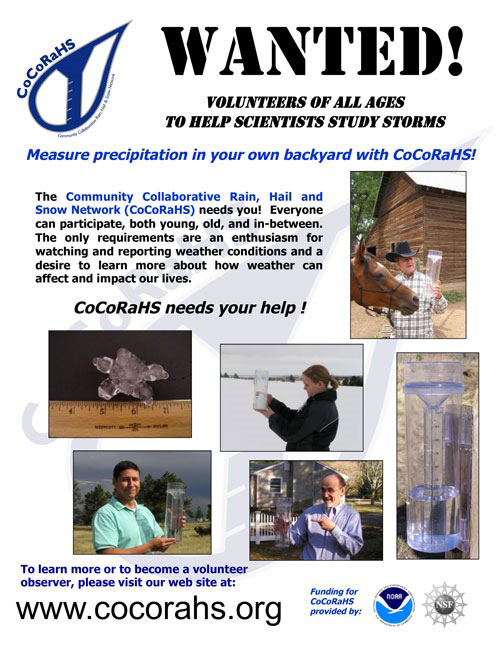Most people think basketball when they hear the phrase “March Madness”. However, in the weather reporting world, March marks the annual recruitment drive for the national Community Collaborative Rain Hail and Snow network (CoCoRaHS). Every state vies for the chance to have the highest number of new recruits during the month of March.
What is CoCoRaHS?
CoCoRaHS is an acronym for the Community Collaborative Rain, Hail and Snow Network. CoCoRaHS is a unique, non-profit, community-based network of volunteers of all ages and backgrounds (Figure 1) working together to measure and map precipitation (rain, hail, and snow). By using a standardized, low cost rain gauge, you can measure precipitation the same way thousands of others do across the nation. The data collected fills weather data gaps across the region and is extremely useful to decision makers. In a recent example, Manhattan was able to document the highest rainfall amount during the Labor Day 2018 flood thanks to a CoCoRaHS observer (Figure 2). This data will shape the understanding of weather/climate in your backyard for decades to come and new observers are greatly needed!

Figure 1. Two young weather reporters in the making! Weed Science Specialist, Sarah Lancaster, sent in this photo of her two sons reading their CoCoRaHS rain gauge following a rain event in late April 2020. Photo by Sarah Lancaster, K-State Research and Extension.

Figure 2. Riley County, KS CoCoRaHS reports for September 3, 2018.
No rain is still an important observation
Volunteers also report when it DOES NOT rain. Documenting the fact that a part of the county missed a precipitation event helps improve our understanding of drought conditions. That information is also useful in improving radar and satellite rainfall estimates. This also reflects the importance of placing your rain gauge in a representative location that adheres to CoCoRaHS siting requirements.
Who uses the CoCoRaHS data?
CoCoRaHS is used by a wide variety of organizations and individuals and accessed free through https://cocorahs.org/. The National Weather Service, hydrologists, emergency managers, city utilities (water supply, water conservation, storm water), insurance adjusters, USDA, engineers, mosquito control, ranchers and farmers, outdoor & recreation interests, teachers, students, and neighbors in the community are just some examples of those who visit the website and use the data.
Joining CoCoRaHS
One of the neat things about participating in this network is coming away with the feeling that you have made an important contribution that helps others. By providing your daily observation, you help to fill in a piece of the weather puzzle that affects many across your area in one way or another.
To join CoCoRaHS, you need to apply at https://cocorahs.org/application.aspx and take the training (found here: https://cocorahs.org/Content.aspx?page=training_slideshows or here: https://www.youtube.com/user/cocorahs). If you don’t have a rain gauge, don’t worry! Just select the appropriate box on the application and we will send you one…FOR FREE.
March is our big push to gain new observers in the United States with a friendly competition. However, don’t worry if you don’t get signed up this month. New observers are welcome any time of the year. In fact, while Kansas hasn’t won either trophy in a number of years, we have seen steady increases in observers with June actually being our top month for recruitment. We have also achieved a significant milestone – highest percentage of new recruits actually making their first observation. It is important to take that second step: once you obtain your gauge, actually deploy the gauge and send in the observations.
If you have questions about the program, contact Chip Redmond at Kansas State University by email at christopherredmond@ksu.edu or phone at 785-477-6204.

Christopher “Chip” Redmond, Kansas Mesonet and Weather Data Library
christopherredmond@ksu.edu
Tags: precipitation weather CoCoRaHS data